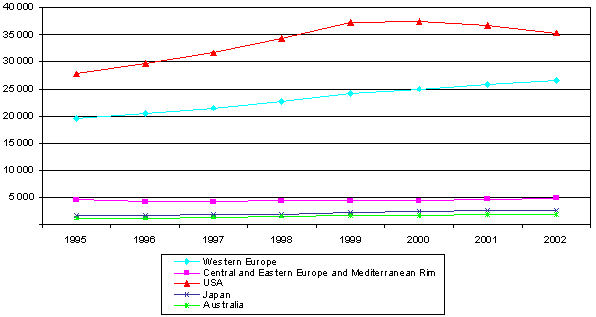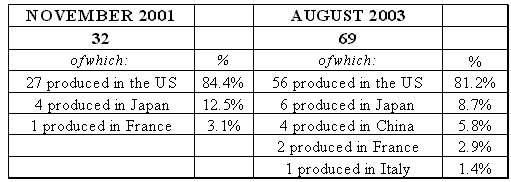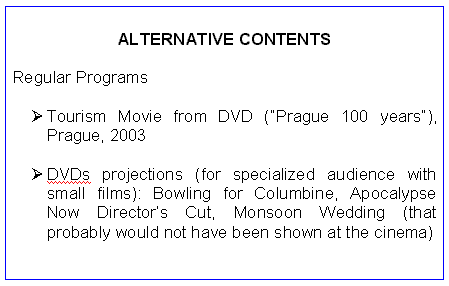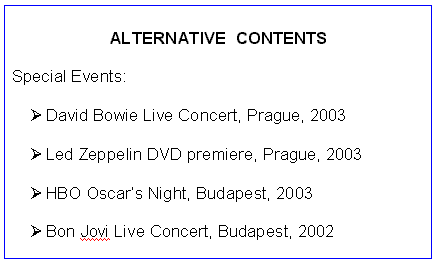|
D-Cinema 4th
International Forum:
ALTERNATIVE CONTENT AND NEW BUSINESS MODELS
Milan, 29 November 2003
Talk by Elisabetta
Brunella
Secretary General of MEDIA Salles
As you know, MEDIA Salles was created in 1991, in the
framework of the then brand-new MEDIA Programme and with the support of
the Italian Government, in order to address exhibitors and to promote
European films in cinemas.
One of the best-known of MEDIA Salles' initiatives is the "European Cinema
Yearbook" which has been collecting data on cinema-going in 32 European
countries since 1989.
As well as an analysis of basic indicators, such as
tickets sold, box office, average pro-capita admissions, number of screens
and seats, market shares of films according to their nationality, MEDIA
Salles decided to devote special sections of the Yearbook to those phenonema
which have influenced and continue to influence the structural transformation
of cinema exhibition, the cinema-going habits of audiences and, more in
general, the economy of the cinema exhibition industry.
For this reason, for some years now the Yearbook has been reporting on
the situation of multiplexes throughout Europe (according to the practice
adopted by MEDIA Salles, this means complexes with at least 8 screens),
whilst the eleventh edition (2002) - has a section devoted to digital
cinema.
This decision is underpinned by the desire to offer precise data to support
evaluation and debate involving operators and companies both inside and
outside the cinema industry on the development and adoption of digital
technology for the production and distribution of films.
In line with this approach, the aim of my talk today is to provide you
with a statistical framework for discussion concerning the digitalisation
of cinemas.
We can see immediately how many screens are equipped for digital screening
and where they are located (update: August 2003).
In recording this data we have taken as our basis the screens that have
adopted the DLP CinemaTM technology produced by Texas Instruments.
There proves to be a total of 162 of these screens, 80 of which are distributed
through North America, 9 in Latin America, 16 in Europe, 55 in Asia and
2 in Australia. Let us compare the 2003 data with the figures recorded
at the end of 2001.
TABLE 1: DIGITAL SCREENS WORLDWIDE (with
DLP CinemaTM Technology produced by Texas Instruments)

From this comparison some interesting observations
emerge:
- in the space of a little under two years there has only been a slight
increase in the number of digital screens in Western Europe
- digital screening has also made an entry - for the moment a decidedly
timid one - into Eastern Europe, Australia and Latin America
- North America has seen the numbers of its digital cinemas increase
fourfold
- Asia, and in particular China, where 34 of the Continent's screens
are located, has shown signs of confidence in this new technology
GRAPH. 1: DIGITAL SCREENS WORLDWIDE (with DLP
CinemaTM Technology produced by Texas Instruments)

In general an attitude of extreme prudence can be observed
on the part of the exhibitors. Indeed, if we examine the trend in the
number of "conventional" screens, it can be seen, for example, that in
Western Europe the past few years have seen significant investments resulting
in a considerable increase in numbers.
Over a seven-year period there has, in fact, been a 36% rise in the number
of screens.
TABLE 2: TOTAL SCREENS WORLDWIDE

GRAPH. 2: TOTAL SCREENS WORLDWIDE

The same confidence does not seem to be
evident, at least for the moment, in the field of digital cinema.
Turning our attention to North America,
the situation seems to be the exact opposite, i.e. marked by an overall
reduction in the number of screens in the United States, starting from
2001, and by a flattering growth in digital screens, in terms of percentage
variation, as they increase almost fourfold in roughly two years. Yet
here, too, this growth has proved to be far smaller that the prospects
that seemed to have been opened up by the release of Star Wars: Episode
II in digital format, in May 2002. It was, in fact, generally believed
that following this event, there would be one thousand digital screens
available in the United States.
Here, too, caution seems to have prevailed.
One of the reasons for this attitude may be found in the difficulties
of obtaining digital films, difficulties which only partly emerge from
the statistics regarding the number of films distributed with DLP CinemaTM
technology.
There were 4 of these in 1999, 12 in 2000, 18 in 2001, 13 in the first
eight months of 2003.
TABLE 3: DIGITAL FILMS WORLDWIDE
(with DLP CinemaTM Technology produced by Texas Instruments)

At a first reading these figures indicate
growth. However, this increase has not affected all markets: in fact some
films were only available for digital screening in one, or very few, territories
and did not experience truly international circulation.
The case of films that were distributed analogically worldwide but only
available in an English-language version for digital screening is significant.
This particular element can, at least partly, offer an explanation for
the stalemate in the situation of digital screens in Western Europe.
Observing the origin of films made available for digital screening, it
can also be seen that the vast majority come from the United States and
that Europe, a territory that is comparable to the United States in terms
of production capacity, has only played a marginal role in this field
up to now.
TABLE 4: DIGITAL FILMS WORLDWIDE
(with DLP CinemaTM Technology produced by Texas Instruments)

To sum up:
- digital screens are spreading very slowly, certainly more slowly
than was predicted;
- the forecasts predicting that 5% of all screens in the United States
would be digital by 2004 have proved unrealistic;
- the cost of equipping a cinema with a digital screen is still in the
region of at least 100,000 euros, a sum that is a long way from that
estimated by economic analyses of the sector for digital screening to
become competitive with respect to analogical screening (50,000 euros);
- The supply of films in digital format is still scarce and irregular.
These factors mean that digital screening remains in an experimental
phase.
Combining the data deriving from statistical surveys
and the information emerging from professional meetings with exhibitors
on the topic of digital cinema organised both by MEDIA Salles and by other
bodies, as well as the results of audience surveys (e.g. the one recently
published by Screen Digest on digital cinemas in California or that carried
out in Italy at the Arcadia cinema in Melzo), it can be seen that the
experimental phase has highlighted some points of vital importance for
the future of digital screening:
-
a positive view of digital technology by audiences
-
increased confidence in the ability of the technology
to provide visual quality comparable to that obtained on conventional
film, particularly in view of the fact that the quality of digital
screening remains constant through time
-
concern that the introduction of digital technology
may modify existing business patterns, as well as the roles and
the equilibrium of the various different operators involved in the
process of the film's life
-
the question of the effects on the general public
of the benefits foreseen from digital screening at the level of
distribution (lower costs and greater flexibility). Will the benefits
expected result in a better offer to the public, both quantitatively
and qualitatively? In other words, will cinemas be able to provide
a more diversified offer, including those films which at present
do not prove so economical to distribute, or will the advantages
for distribution be in favour of an even more crushing presence
of those films that already cover 30% and more of a country's screens?
Up until here, we have spoken of digital screening "applied
to existing content", or to full-length features.
In this phase, which we have called experimental, digital screening has
already demonstrated that what we might call its main characteristic,
i.e. flexibility, can also find its expression in different "applications".
This is the terrain that John Fithan, President of the US exhibitors'
association (NATO), for example, defines as ODS - other digital stuff.
To give an example of this concept, without venturing
too far into theory or the realm of the futuristic, I should like to quote
a practical case of how a movie theatre equipped for digital screening
with DLP CinemaTM equipment by Texas Instruments is used, both from a
traditional perspective (the full-length feature typical of 35mm screening),
and from that of ODS.
I refer to the experience of Palace Cinemas, outlined by its Director
General, VJ Maury, during the training course for European exhibitors
"European Cinema Exhibition - A New Approach", promoted by MEDIA Salles
in Rome last September.
Palace Cinemas manages a new generation of cinemas in
three countries in Central-Eastern Europe: the Czech Republic, the Slovak
Republic and Hungary.
Two of these cinemas are fitted WITH one digital screen each (DLP CinemaTM
di Texas Instruments).
They are the only digital screens operating in this part of Europe.
Tab 5 PALACE CINEMAS:
AN OVERVIEW

THE PALACE CINEMAS MOVIE THEATRES FITTED
WITH DLP CINEMA TM TECHNOLOGY
(Sponsor: Pepsi Cola)

I should point out that the provision of Palace Cinemas'
two digital screens was sponsored by Pepsi Cola
This can be considered proof of the interest that the transition to digital
screening arouses in companies operating in other sectors, which intend
both to develop their own business and to associate their image with a
process that is considered innovative and of great attraction to the general
public.
Returning to our main topic, I should like to give you some data on Palace
Cinemas' digital programming.
The figures regarding films in the traditional sense of the term is fairly
disappointing but certainly in line with what has been said about the
scarce availability of digital films.
PROGRAMMING OF FULL-LENGTH FEATURES IN
DIGITAL FORMAT AT PALACE CINEMAS

The two theatres thus turned to alternative content,
which can be divided into two categories: events and regular programming.
A "regular" offer is made by the Prague screen which, thanks to its location
in the city centre, can be used to run a "film with tourist content" in
the late morning and early afternoon, specially intended for visitors
to Prague.
PALACE CINEMAS PROGRAMMING OF ALTERNATIVE
CONTENT IN DIGITAL

FORMAT AT THE PALACE CINEMAS
In this case Palace Cinemas holds the rights to the
film and thus controls its programming.
Things are different in the case of "events", for which the Palace Cinemas
offer is linked - and depends on - their production, although to a varying
degree according to whether the event is a live concert, such as David
Bowie's, or the launch of a new music DVD.
PROGRAMMING OF ALTERNATIVE CONTENT IN
DIGITAL FORMAT AT PALACE CINEMAS

From this experience "in the field" VJ Maury identifies
the field of "visual music" as one of the most promising for "ODS" in
cinemas.
It is interesting to note that "content other than films" tends to develop
"alternative uses" of the cinema. As an example of this concept, I would
quote the distinction made by Maria Grazia Mattei in her article of the
19 October for the "Sole 24 Ore", with observations by VJ Maury based
on the experience gained from the organisation of the "events" listed
above.
During a live concert at the cinema, the audience behaves as if it were
at a party, for example going in and out of the theatre or standing up
rather than remaining seated.
In addition, business at the bar becomes more or less
continuous, generating a higher proportion of takings with respect to
takings from tickets, than that made during the screening of a film.
Alternative content and an alternative use of the movie theatre also draws
a different type of audience.
Could this be a way of attracting those who are not habitual cinemagoers
to "traditional cinema"?
Or will it lead to the cinema's loss of identity, exposed as it is to
threats by new modes of accessing films and images, which are multiplying
thanks also to the technology?
With this question, addressed both to managers of distribution and theatres,
and to those who produce content, I hand over to the next speakers.

|

